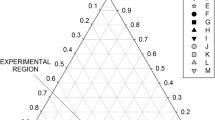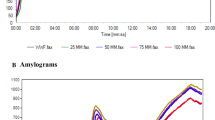Abstract
To meet the needs of new consumers, meat researchers need to develop healthier products. Dietary fibers can be added for structural purposes, to present functional characteristics or to change the composition of the final product. In this study, mixture design was used to investigate the effects of partial substitution of pork fat by inulin, fructooligosaccharides and α-cyclodextrin on the technological and sensory quality characteristics of low-fat Italian type salami. The partial substitution of fat using dietary fibers shows no effect on weight loss, Aw and pH during ripening time. However, the addition of up to 2% α-cyclodextrin increased lightness and reduced redness and yellowness. Up to 2% of inulin or fructooligosaccharides added improved the sensory acceptance, texture parameters and redness. Healthier low-fat Italian type salami can be produced using inulin or fructooligosaccharides as fat substitute for pork fat and still obtain good technological and sensorial results.


Similar content being viewed by others
References
ABPA (2012) Associação Brasileira de Proteína Animal (ABPA). Relatório anual ABIPECS 2011/2012- Carne Suína. São Paulo, Brasil
Alejandre M, Poyato C, Ansorena D, Astiasaran I (2016) Linseed oil gelled emulsion: a successful fat replacer in dry fermented sausages. Meat Sci 121:107–113
Alves LAAS, Lorenzo JM, Gonçalves CAA, Santos BA, Heck RT, Cichoski AJ, Campagnol PCB (2016) Production of healthier Bologna type sausages using pork skin and green banana flour as fat replacers. Meat Sci 121:73–78
Anarjan N, Fahimdanesh M, Malmiri-Jafarizadeh H (2017) β-Carotene nanodispersions synthesis by three-component stabilizer system using mixture design. J Food Sci Technol 54:3731–3736
Bailey MA, Holscher HD (2018) Microbiome-mediated effects of the Mediterranean diet on inflammation. Adv Nutr 9:193–206
Bis-Souza CV, Henck JMM, Barretto ACS (2018) Performance of low-fat beef Burger with added soluble and insoluble dietary fibers. Food Sci Technol 38:522–529
Bis-Souza CV, Barba FJ, Lorenzo JM, Penna ALB, Barretto ACS (2019) New strategies for the development of innovative fermented meat products: a review regarding the incorporation of probiotics and dietary fibers. Food Rev Int 35:467–484
Blaiotta G, Murru N, Cerbo AD, Romano R, Aponte M (2018a) Production of probiotic bovine salami using Lactobacillus plantarum 299v as adjunct. J Sci Food Agric 98:2285–2294
Blaiotta G, Murru N, Cerbo AD, Romano R, Aponte M (2018b) Production of probiotic bovine salami using Lactobacillus plantarum 299v as adjunct. J Sci Food Agric 98:2285–2294
Bligh EG, Dyer WJ (1959) A rapid method of total lipid extraction and purification. Can J Biochem Physiol 37:911–917
Bourne MC (1978) Texture profile analysis. Food Technol 32:62–66
Brazil (2000) Ministério da Agricultura, Pecuária e Abastecimento (MAPA). Instrução Normativa IN No 22/2000. Regulamento técnico de identidade e qualidade de salame tipo italiano. Diário Oficial da União; Poder Executivo, Brasília
Brazil (2001) Agência Nacional de Vigilância Sanitária (ANVISA). Resolução RDC No 12/2001. Regulamento Técnico sobre Padrões Microbiológicos para Alimentos. Diário Oficial da União; Poder Executivo, Brasília
Brazil (2012) Ministério da Saúde. Agencia Nacional de Vigilância Sanitária (ANVISA) Resolução RDC No 54/2012. Regulamento Técnico sobre Informação Nutricional Complementar. Diário Oficial da União; Poder Executivo, Brasília
Caceres E, Garcia ML, Toro J, Selgas MD (2004) The effect of fructooligosaccharides on the sensory characteristics of cooked sausages. Meat Sci 68:87–96
Campagnol PCB, Santos BA, Wagner R, Terra NN, Pollonio MAR (2012) Amorphous cellulose gel as a fat substitute in fermented sausages. Meat Sci 90:36–42
Casarotti SN, Borgonovi TF, Batista CL, Penna ALB (2018) Guava, orange and passion fruit by-products: characterization and its impacts on kinetics of acidification and properties of probiotic fermented products. LWT Food Sci Technol 98:69–76
Cruxen CES, Braun CLK, Fagundes MB, Gularte MA, Wagner R, Silva WP, Fiorentini AM (2018) Development of fermented sausage produced with mutton and native starter cultures. LWT Food Sci Technol 95:23–31
De Moraes Filho ML, Busanello M, Prudencio SH, Garcia S (2018) Soymilk with okara flour fermented by Lactobacillus acidophilus: simplex-centroid mixture design applied in the elaboration of probiotic creamy sauce and storage stability. LWT Food Sci Technol 93:339–345
Días-Vela J, Totosaus A, Escalona-Buendía BH, Pérez-Chabela ML (2017) Influence of the fiber from agro-industrial co-products as functional food ingredient on the acceptance, neophobia and sensory characteristics of cooked sausages. J Food Sci Technol 54:379–385
Fernández-López J, Sendra E, Sayas-Barberá E, Navarro C, Pérez-Alvarez JA (2008) Physico-chemical and microbiological profiles of “salchichón” (Spanish dry-fermented sausage) enriched with orange fiber. Meat Sci 80:410–417
Ferreira V, Barbosa J, Vendeiro S, Mota A, Silva F, Monteiro MJ, Hogg T, Gibbs P, Teixeira P (2006) Chemical and microbiological characterization of alheira: a typical Portuguese fermented sausage with particular reference to factors relating to food safety. Meat Sci 73:570–575
Glisic M, Baltic M, Trbovic D, Jokanovic M, Pnrunovic N, Dimitrijevic M, Suvajdzic B, Boskovic M, Vasilev D (2019) Inulin-based emulsion-filled gel as a fat replacer in prebiotic and PUFA-enriched dry fermented sausages. Int J Food Sci Technol 54:787–797
Greene BE, Cumuze TH (1982) Relationship between TBA numbers and inexperienced panelists’ assessments of oxidized flavor in cooked beef. J Food Sci 47:52–54
Grigelmo-Miguel N, Abadías-Serós MAI, Martín-Belloso O (1999) Characterisation of low-fat high-dietary fibre frankfurters. Meat Sci 52:247–256
Ham YK, Hwang KE, Kim HW, Song DH, Kim YJ, Choi YS, Kim CJ (2016) Effect of fat replacement with a mixture of collagen and dietary fiber on small caliber fermented sausages. Int J Food Sci Technol 51:96–104
Han M, Bertram HC (2017) Designing healthier comminuted meat products: effect of dietary fibers on water distribution and texture of a fat-reduced meat model system. Meat Sci 133:159–165
Henning SSC, Tshalibe P, Hoffman LC (2016) Physico-chemical properties of reduced-fat beef species sausage with pork back fat replaced by pineapple dietary fibres and water. LWT Food Sci Technol 74:92–98
Hilbig J, Gisder J, Prechtl RM, Herrmann K, Weiss J, Loeffler M (2019) Influence of exopolysaccharide-producing lactic acid bacteria on the spreadability of fat-reduced raw fermented sausages (Teewurst). Food Hydrocolloids 93:422–431
Horwitz W, Latimer GW (2007) Association of official analytical chemistry—AOAC. 2007. Official methods of analysis, 18th edn. AOAC International, Gaithersburg
Keenan DF, Resconi VC, Kerry JP, Hamill RM (2014) Modelling the influence of inulin as a fat substitute in comminuted meat products on their physico-chemical characteristics and eating quality using a mixture design approach. Meat Sci 94:1384–1394
Lopez-Lopez I, Cofrades S, Yakan A, Solas MT, Jimenez-Colmenero F (2010) Frozen storage characteristics of low-salt and low-fat beef patties as affected by Wakame addition and replacing pork backfat with olive oil-in-water emulsion. Food Res Int 43:1244–1254
López-Vargas J, Fernández-López J, Pérez-Álvarez JA, Viuda-Martos M (2014) Quality characteristics of pork burger added with albedo-fiber powder obtained from yellow passion fruit (Passiflora edulis var. flavicarpa) co-products. Meat Sci 97:270–276
Marino R, Malva AD, Seccia A, Caroprese M, Sevi C, Albenzio M (2017) Consumers’ expectations and acceptability for low saturated fat ‘salami’: healthiness or taste? J Sci Food Agric 97:3515–3521
Meilgaard M, Civille GV, Carr BT (1999) Sensory evaluation techniques, 3rd edn. CRC, Boca Raton
Menegas LZ, Pimentel TC, Garcia S, Prudencio SH (2013) Dry-fermented chicken sausage produced with inulin and corn oil: physicochemical, microbiological, and textural characteristics and acceptability during storage. Meat Sci 93:501–506
Park W, Kim JR, Ju MG, Hong GE, Yeon SJ, Seo HG, Lee CH (2017) Enhancing quality characteristics of salami sausages formulated with whole buckwheat flour during storage. J Food Sci Technol 54:326–332
Pérez-Burillo S, Mehta T, Pastoriza S, Kramer DL, Paliy O, Rufián-Henares JÁ (2019) Potential probiotic salami with dietary fiber modulates antioxidant capacity, short chain fatty acid production and gut microbiota community structure. LWT Food Sci Technol 105:355–362
Prado N, Sampayo M, González P, Lombó F, Díaz J (2019) Physicochemical, sensory and microbiological characterization of Asturian Chorizo, a traditional fermented sausage manufactured in Northern Spain. Meat Sci 156:118–124
Rocha YJP, Noronha RLF, Trindade MA (2019) Relations between consumer’s concern with own health and their perception about frankfurters with functional ingredients. Meat Sci 155:91–101
Ruiz JN, Villanueva NDM, Favaro-Trindade CS, Contreras-Castillo CJ (2014) Physicochemical, microbiological and sensory assessments of Italian salami sausage with probiotic potential. Sci Agric 71:204–211
Salazar P, García ML, Selgas MD (2009) Short-chain fructooligosaccharides as potential functional ingredients in dry fermented sausages with different fat levels. Int J Food Sci Technol 44:1100–1107
Santos BA, Pollonio MAR, Cruz AG, Messias VC, Monteiro RA, Oliveira TLC, Faria JAF, Freitas MQ, Bolini HMA (2013) Ultra-flash profile and projective mapping for describing sensory attributes of prebiotic mortadella. Food Res Int 54:1705–1711
Sarteshnizi RA, Hosseini H, Bondarianzadeh D, Colmenero FJ, Khaksar R (2015) Optimization of prebiotic sausage formulation: effect of using b-glucan and resistant starch by D-optimal mixture design approach. LWT- Food Sci Technol 62:704–710
Szczesniak AS (2002) Texture in a sensory property. Food Qual Prefer 13:215–225
Vyncke W (1970) Direct determination of the thiobarbituric acid value in trichloracetic acid extracts of fish as a measure of oxidative rancidity. Eur J Lipid Sci Technol 72:1084–1087
Yim DG, Jang KH, Chung KY (2016) Effect of fat level and the ripening time on quality traits of fermented sausages. Asian Australas J Anim Sci 29:119–125
Zhao Y, Hou Q, Zhuang X, Wang Y, Zhou G, Zhang W (2018) Effect of regenerated cellulose fiber on the physicochemical properties and sensory characteristics of fat-reduced emulsified sausage. LWT- Food Sci Technol 97:157–163
Zhou T, Zhao Y, Wu X, Wang W, Liu A (2018) Production of squid emulsion sausages using pork skin and coconut powder mixture as fat replacers. Int J Food Sci Technol 53:747–754
Zhuang XB, Han MY, Kang ZL, Wang K, Bai Y, Xu XL (2016) Effects of the sugarcane dietary fiber and pre-emulsified sesame oil on low-fat meat batter physicochemical property, texture, and microstructure. Meat Sci 113:107–115
Author information
Authors and Affiliations
Corresponding author
Additional information
Publisher's Note
Springer Nature remains neutral with regard to jurisdictional claims in published maps and institutional affiliations.
Rights and permissions
About this article
Cite this article
Bis-Souza, C.V., Ozaki, M.M., Vidal, V.A.S. et al. Can dietary fiber improve the technological characteristics and sensory acceptance of low-fat Italian type salami?. J Food Sci Technol 57, 1003–1012 (2020). https://doi.org/10.1007/s13197-019-04133-6
Revised:
Accepted:
Published:
Issue Date:
DOI: https://doi.org/10.1007/s13197-019-04133-6




